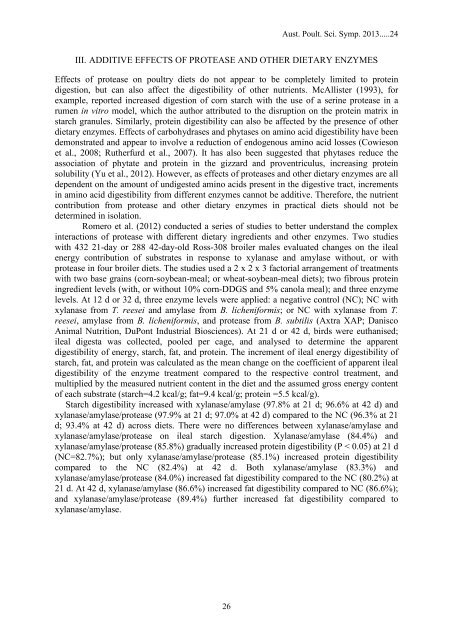APSS 2013 Proceedings - The University of Sydney
APSS 2013 Proceedings - The University of Sydney
APSS 2013 Proceedings - The University of Sydney
Create successful ePaper yourself
Turn your PDF publications into a flip-book with our unique Google optimized e-Paper software.
Aust. Poult. Sci. Symp. <strong>2013</strong>.....24<br />
III. ADDITIVE EFFECTS OF PROTEASE AND OTHER DIETARY ENZYMES<br />
Effects <strong>of</strong> protease on poultry diets do not appear to be completely limited to protein<br />
digestion, but can also affect the digestibility <strong>of</strong> other nutrients. McAllister (1993), for<br />
example, reported increased digestion <strong>of</strong> corn starch with the use <strong>of</strong> a serine protease in a<br />
rumen in vitro model, which the author attributed to the disruption on the protein matrix in<br />
starch granules. Similarly, protein digestibility can also be affected by the presence <strong>of</strong> other<br />
dietary enzymes. Effects <strong>of</strong> carbohydrases and phytases on amino acid digestibility have been<br />
demonstrated and appear to involve a reduction <strong>of</strong> endogenous amino acid losses (Cowieson<br />
et al., 2008; Rutherfurd et al., 2007). It has also been suggested that phytases reduce the<br />
association <strong>of</strong> phytate and protein in the gizzard and proventriculus, increasing protein<br />
solubility (Yu et al., 2012). However, as effects <strong>of</strong> proteases and other dietary enzymes are all<br />
dependent on the amount <strong>of</strong> undigested amino acids present in the digestive tract, increments<br />
in amino acid digestibility from different enzymes cannot be additive. <strong>The</strong>refore, the nutrient<br />
contribution from protease and other dietary enzymes in practical diets should not be<br />
determined in isolation.<br />
Romero et al. (2012) conducted a series <strong>of</strong> studies to better understand the complex<br />
interactions <strong>of</strong> protease with different dietary ingredients and other enzymes. Two studies<br />
with 432 21-day or 288 42-day-old Ross-308 broiler males evaluated changes on the ileal<br />
energy contribution <strong>of</strong> substrates in response to xylanase and amylase without, or with<br />
protease in four broiler diets. <strong>The</strong> studies used a 2 x 2 x 3 factorial arrangement <strong>of</strong> treatments<br />
with two base grains (corn-soybean-meal; or wheat-soybean-meal diets); two fibrous protein<br />
ingredient levels (with, or without 10% corn-DDGS and 5% canola meal); and three enzyme<br />
levels. At 12 d or 32 d, three enzyme levels were applied: a negative control (NC); NC with<br />
xylanase from T. reesei and amylase from B. licheniformis; or NC with xylanase from T.<br />
reesei, amylase from B. licheniformis, and protease from B. subtilis (Axtra XAP; Danisco<br />
Animal Nutrition, DuPont Industrial Biosciences). At 21 d or 42 d, birds were euthanised;<br />
ileal digesta was collected, pooled per cage, and analysed to determine the apparent<br />
digestibility <strong>of</strong> energy, starch, fat, and protein. <strong>The</strong> increment <strong>of</strong> ileal energy digestibility <strong>of</strong><br />
starch, fat, and protein was calculated as the mean change on the coefficient <strong>of</strong> apparent ileal<br />
digestibility <strong>of</strong> the enzyme treatment compared to the respective control treatment, and<br />
multiplied by the measured nutrient content in the diet and the assumed gross energy content<br />
<strong>of</strong> each substrate (starch=4.2 kcal/g; fat=9.4 kcal/g; protein =5.5 kcal/g).<br />
Starch digestibility increased with xylanase/amylase (97.8% at 21 d; 96.6% at 42 d) and<br />
xylanase/amylase/protease (97.9% at 21 d; 97.0% at 42 d) compared to the NC (96.3% at 21<br />
d; 93.4% at 42 d) across diets. <strong>The</strong>re were no differences between xylanase/amylase and<br />
xylanase/amylase/protease on ileal starch digestion. Xylanase/amylase (84.4%) and<br />
xylanase/amylase/protease (85.8%) gradually increased protein digestibility (P < 0.05) at 21 d<br />
(NC=82.7%); but only xylanase/amylase/protease (85.1%) increased protein digestibility<br />
compared to the NC (82.4%) at 42 d. Both xylanase/amylase (83.3%) and<br />
xylanase/amylase/protease (84.0%) increased fat digestibility compared to the NC (80.2%) at<br />
21 d. At 42 d, xylanase/amylase (86.6%) increased fat digestibility compared to NC (86.6%);<br />
and xylanase/amylase/protease (89.4%) further increased fat digestibility compared to<br />
xylanase/amylase.<br />
26
















